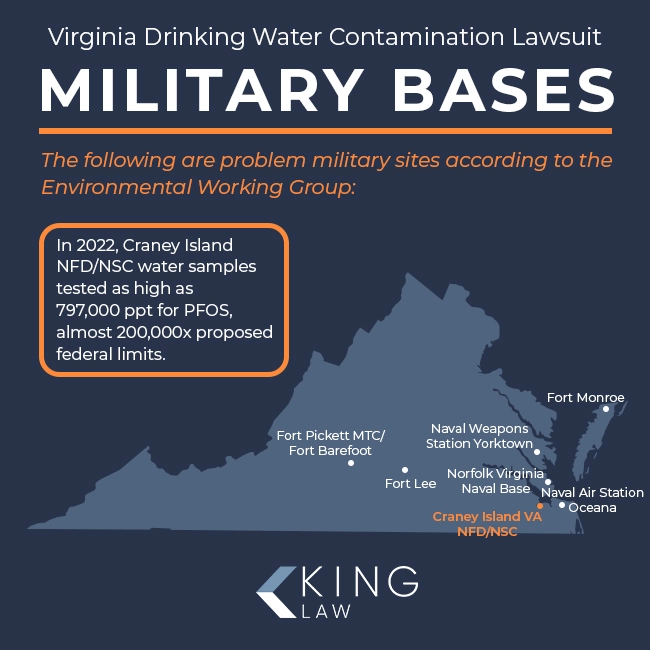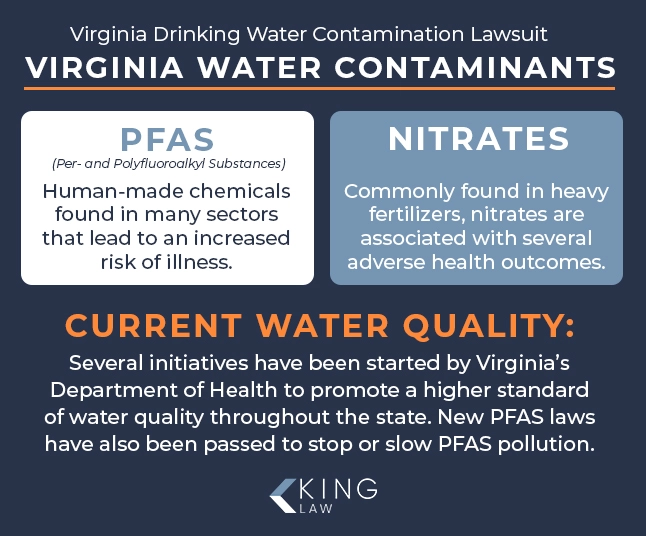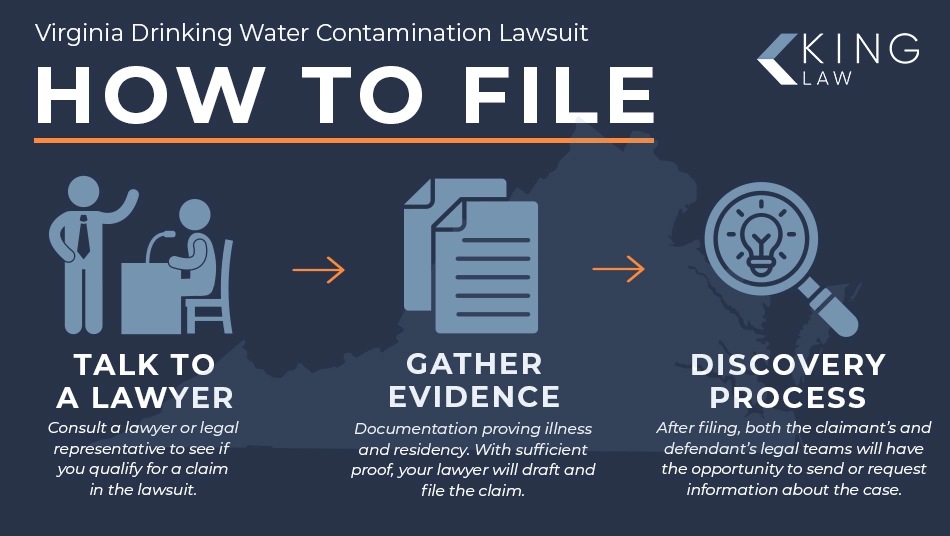See if You Qualify

For years, defense operations, airports, businesses, and residents have been pouring PFAS into Virginia’s vital waterways. Now, people who have been sickened by contaminated water are filing lawsuits against the companies who made these dangerous chemicals and polluted drinking water.
PFAS are a group of human-made substances made popular because of their usefulness in nonstick cookware and firefighting foam. However, these chemicals are highly hazardous to human health. Many people in Virginia have been drinking water that was contaminated with these substances. Because of this, Virginians are developing kidney, pancreatic, breast, testicular, and kidney cancer, and various diseases.
Victims are filing water contamination lawsuits against the organizations that poisoned the drinking water in Virginia. They are seeking vital compensation to help them move forward and encourage necessary change to protect future generations.
About the Virginia Water Contamination Lawsuit
Virginia Water Contamination Lawsuit Overview
Timeline of Water Contamination in Virginia | 2025 Update
Sources of Water Contamination in Virginia
Virginia’s Regulations for Drinking Water
Contaminants Found in Virginia Drinking Water
Current Water Quality in Virginia
Health Risks and Symptoms Linked to Drinking Water in Virginia
Eligibility Criteria for the Virginia Water Contamination Lawsuit
Virginia Water Contamination Settlement and Payout Amounts
How to File a Virginia Water Contamination Lawsuit
Statute of Limitations for Virginia Water Contamination Claims
Virginia Water Contamination Lawsuit Overview
Virginia is home to dozens of defense operations and communities, including the historic Arlington, Fort Monroe, Virginia Beach, and Fort Eustis. Aqueous film-forming foam, also known by its acronym, AFFF, was a preferred tool for putting out fires on bases and at airports in Virginia. Sadly, while many consider this material to be unparalleled in its ability to extinguish fuel fires, it comes at a cost.
AFFF gets its edge from per- and polyfluoroalkyl substances (called PFAS), which are highly water-resistant and toxic. PFAS are known to cause multiple types of cancers, as well as diseases like ulcerative colitis and thyroid disease. Military, industrial, and agricultural operations that used PFAS-containing firefighting foams were hubs of contamination in Virginia. The firefighting foams would seep into the ground and poison the groundwater sources underneath.
In 2021, an Environmental Working Group report revealed that the tap water in many Virginia towns had unsafe levels of PFAS, putting thousands at risk. Affected Virginia residents are suing the institutions that contaminated their drinking water, hoping to reclaim their agency and recoup settlements to address their losses.
Timeline of Water Contamination in Virginia | 2025 Update
August 2025: Researchers at Virginia Tech Hope to Create PFAS-free Firefighting Foams
Much of the PFAS water contamination in Virginia and throughout the United States can be traced back to AFFF firefighting foams. These foams were once commonplace to combat liquid fuel fires at airports, military installations, and other areas. Now, researchers at Virginia Tech are trying to create these foams without the use of dangerous PFAS. The researchers not only aim to decrease future pollution in the Occoquan Reservoir, they also hope to decrease future PFAS pollution in the nation’s drinking water supplies.
June 2025: Virginia Tech Is Working to Make Firefighting Foam Without PFAS
Teams at Virginia Tech are working to develop effective and safe firefighting foam that does not rely on cancer-causing PFAS. PFAS do not break down when they encounter water or oil, so they are hard to replace. However, Virginia Tech is committed to finding alternatives that will keep Virginians safe from forever chemicals and fires.
May 2025: EPA Announces New PFAS Federal Action Plan
The EPA has unveiled its new action plan to keep PFAS out of Americans’ drinking water, which will benefit Virginians. The EPA says it will continue to enforce the newly issued maximums for PFAS and PFOA, which all water systems must follow by 2031. However, the agency said it is still evaluating how it will regulate the so-called GenX class of PFAS, which includes PFHxS and PFNA. The EPA also said it is committed to creating resources to help state and local governments meet the EPA’s targets.
April 2, 2025: Virginia Creates Occoquan Reservoir PFAS Reduction Program
Virginia’s congress has passed a law that creates a PFAS reduction program to keep the Occuquan Reservoir free of forever chemicals. The new regulation requires certain facilities to track the PFAS in their water supplies and report these values to the Virginia Department of Environmental Quality (VDEQ). The facility would also need to work with the DEQ to reduce its PFAS levels to the maximums in effect at that time.
April 2, 2024: Virginia Establishes PFAS Advisory Council
Virginia lawmakers have created a new PFAS Expert Advisory Council, which is charged with guiding Virginia’s government efforts to clean up the state’s waterways. The PFAS Council will review water quality reports, evaluate the effectiveness of any water treatment efforts, and recommend actions to help curb PFAS levels.
March 22, 2023: Some Industrial Businesses Required to Test for PFAS in Water Supplies
Industrial businesses that process materials or waste with PFAS in it must test the PFAS levels in the water before and after. The goal is to identify when PFAS contamination is occurring and at what rate, so public and private entities can take action early on. These organizations must send these figures to the Virginia government for monitoring.
October 2021: Middle Chickahominy River in Virginia Polluted with PFAS
The Virginia Department of Environmental Quality received a report that the Middle Chickahominy River watershed had PFAS levels that exceeded the advisory levels. The VDEQ had been monitoring the area for some time to determine the contamination levels and sources. Because of these findings, the Virginia government cautioned some residents against eating fish they caught from the region, such as Chickahominy Lake.
Sources of Water Contamination in Virginia
Virginia is an active hub for many different sectors, which have contributed to the contamination of drinking water sources. For example, agricultural operations use toxic pesticides, herbicides, and fertilizers, which can increase the amount of nitrates and PFAS in the water. Commercial airports produce runoff from fuel, lubricants, firefighting foams, and other materials, which spill off into the groundwater. Military bases are also hotspots for contamination from industrial firefighting foam, gasoline, propellants, and other chemicals, which inject PFAS into the land, air, and water. Many people have filed lawsuits related to PFAS contamination.
Water Contamination From Military Installations
Military bases and sites are common sources of water contamination because of the firefighting foams these organizations use. Unfortunately, PFAS are in firefighting foams, so decades worth of pollution occurred without the public or service members knowing about it. The website, Military Installations, includes the following in its directory of military sites in Virginia:
- Defense Supply Center Richmond
- DLA McNamara HQC
- Fort Belvoir
- Fort Lee
- Fort Myer (Joint Base Myer – Henderson Hall)
- Henderson Hall (Joint Base Myer – Henderson Hall)
- Joint Base Langley-Eustis
- Joint Expeditionary Base Little Creek-Fort Story
- Marine Corps Base Quantico
- MCCS Hampton Roads
- Naval Air Station Oceana
- Naval Air Station Oceana Dam Neck Annex
- Naval Medical Center Portsmouth
- Naval Station Norfolk
- Naval Support Activity Hampton Roads
- Naval Support Activity Hampton Roads Northwest Annex
- Naval Support Activity South Potomac (NSF Dahlgren)
- Naval Weapons Station Yorktown
- Newport News Shipyard
- Norfolk Naval Shipyard (asbestos at shipyards is also common)
- Surface Combat Systems Center Wallops Island
- USAREC, Richmond Recruiting Battalion
- 192 FW
According to the Environmental Working Group, some of these military installations have a history of PFAS contamination. Here are a few of the problem sites the Environmental Working Group has identified:
- Fort Lee (2020): 10,000 ppt (PFOS); 8,500 ppt (PFOA)
- Fort Pickett MTC/Fort Barfoot (2023): 39,000 ppt (PFHxS); 5,400 ppt (PFOA); 8,400 ppt (PFOS)
- Naval Weapons Station Yorktown – Cheatham Annex (2022): 5,600 ppt (PFOA); 14,100 ppt (PFHxS)
- Norfolk Virginia Naval Base (2022): 186,000 ppt (PFOS); 17,000 ppt (PFOA); 61,100 ppt (PFHxS); 19,100 ppt (PFBS)
- Fort Monroe (2023): 3,200 ppt (PFOS)
- Naval Air Station Oceana (2016): 493,600 ppt (PFOS+PFOA)
- Craney Island VA NFD/NSC (2022): 797,000 ppt (PFOS); 198,000 ppt (PFHxS); 63,600 ppt (PFOA)
Those who worked or lived on or near these bases may have been drinking water contaminated with cancer-causing PFAS.

Virginia’s Regulations for Drinking Water
Several Virginia agencies are working to reduce the amount of PFAS in the water supplies throughout the state. Virginia does not have state-level regulations that set its own PFAS levels; however, the state is taking steps to comply with the EPA’s current maximums.
Additionally, Virginia has several efforts underway to monitor and curb contamination. For example, an advisory council was created to help inform regulators and the Virginia Departments of Health and Environmental Quality about PFAS levels and recommendations to protect residents. Additionally, Virginia publishes the results of water quality tests, and the federal government hosts an interactive map so residents know what waterways are potential hotspots of PFAS contamination.
Contaminants Found in Virginia Drinking Water
A 2015 EPA report revealed that about 35 million pounds of nitrates were dumped into Virginia’s land and waters during that year. Virginia’s waterways are still carrying the weight of those contaminants through to the present day, despite enormous cleanup efforts in the years since. PFAS (PFOA, PFOS, PFHxS, etc.) and nitrates are a few of the top contaminants, both of which can be dangerous to human health.
Per- and Polyfluoroalkyl Substances (PFAS)
Much of the waterways in Virginia are contaminated with PFAS from nearby industrial, military, and agricultural efforts in the state. PFAS, also called forever chemicals or per- and polyfluoroalkyl substances, are human-made substances that are used in many sectors, ranging from cosmetics, cookware, outdoor gear, firefighting foam, and fertilizer. For example, firefighting foam used on military bases has PFAS in it. These chemicals are known to cause cancer, especially in high quantities.
PFAS do not break down in our bodies, and they take thousands of years to break down in the environment. The buildup of PFAS in our systems over time can prevent some of our organs (like our kidneys, thyroid, liver, and pancreas) from working correctly. As a result, we are more likely to develop cancer. PFAS exposure has been linked with multiple cancers, including kidney cancer, testicular cancer, and pancreatic cancer. Because of this, it is important that federal, state, and local governments work to lower the levels of PFAS in Virginians’ drinking water.
Nitrates
Another significant source of water contamination in Virginia is nitrates, particularly in the roughly 22 percent of rural and private wells in Virginia. Nitrates are commonly found in heavy fertilizers that are used on large farms to enrich the soil and increase the crop they produce. Nitrates have been associated with several adverse health outcomes, including bowel (colorectal) cancer, thyroid disease, and problems with how a baby’s nervous system develops in the womb.

Current Water Quality in Virginia
While many public agencies have taken great strides in helping to clean up Virginia’s drinking water, many cities still have tap water that is contaminated with PFAS and other toxins. Virginia’s Department of Health has several initiatives in place to help make sure the waters are safe. Additionally, Virginia has many laws and regulations to promote a high standard of water quality throughout the state.
Water Treatment Efforts in Virginia
Virginia’s government has created task forces and passed new PFAS laws to help encourage organizations to stop or slow PFAS pollution. For example, Virginia law requires some organizations to test the water before and after they process materials that have forever chemicals on or in them. Virginia’s Office of Drinking Water also maintains an online PFAS contamination map, so residents are aware of the levels in different areas in Virginia.
Health Risks and Symptoms Linked to Drinking Water in Virginia
Drinking water contaminated with PFAS poses significant health risks. For example, PFAS exposure has been shown to increase someone’s thyroid cancer risk by up to 56 percent. Likewise, researchers have found that pregnant women and their unborn babies may experience thyroid problems when exposed to PFAS. PFAS were also associated with a thirteen-fold higher chance of breast cancer. Other conditions that have been linked with PFAS include ulcerative colitis, kidney cancer, leukemia, and non-Hodgkin lymphoma.
Virginians are encouraged to track any new or worrying changes to their health providers. Early detection can be helpful to get the treatment and diagnosis needed to protect their well-being. Many Virginians have been drinking unsafe water without being aware of it, because most of the contaminants (like PFAS) do not affect the taste, smell, or appearance of the water.
Eligibility Criteria for the Virginia Water Contamination Lawsuit
Virginians who drank contaminated water and became sick because of it may be eligible for a settlement. Here are some of the criteria they might need to meet to request compensation:
- They lived in Virginia for at least one year, or they were stationed in Virginia for at least six months.
- They lived or were stationed somewhere with drinking water that was contaminated with PFAS.
- After they were exposed to PFAS, they were diagnosed with a PFAS-related condition (e.g., ulcerative colitis, testicular cancer, thyroid cancer, or kidney cancer).
The person should also have evidence to support their claim, such as deeds or leases for their Virginia residence, as well as records of their medical diagnosis. Attorneys are valuable resources to help the person understand what the updated criteria are and how they can meet them.
Virginia Water Contamination Settlement and Payout Amounts
The exact settlement that someone receives will be determined based on their unique case. However, some victims may receive between $30,000 and $300,000 if they win their lawsuit or receive a settlement. Virginia victims can help increase their chances of securing a financial award by locating strong evidence to show that they were harmed by PFAS in their drinking water. Seasoned lawyers can discuss a victim’s situation and provide a personalized estimate for the compensation package they might receive.
How to File a Virginia Water Contamination Lawsuit
Filing a Virginia water contamination lawsuit begins with talking to a lawyer about your possible claim. Then, you would hire a lawyer and work with them to gather the materials necessary for them to write up a legal complaint. Once they file this document, they will serve it on the entity responsible for the contamination. Next, they would participate in discovery, which is when each side requests and sends in information about the case. The attorney would then use the evidence to craft and negotiate a fair settlement on your behalf or proceed to trial.

Evidence to Support Your VA Water Contamination Claim:
You need to have evidence to support your claim that your water was contaminated with PFAS. One piece of evidence you may want to locate is documents that prove you lived or were stationed in Virginia. Additionally, you will need medical records showing that your doctor evaluated you and diagnosed you with one of the cancers or diseases associated with PFAS exposure. Other useful records include requests for time off for treatments or recovery, as well as research articles that connect PFAS with your condition.
Statute of Limitations for Virginia Water Contamination Claims
You need to file your Virginia water contamination lawsuit before the statute of limitations runs out. The statute of limitations is the window of time that you have to bring a legal claim against someone. The deadline you are given depends on many factors, including the applicable law and your circumstances.
If you were a minor when you drank PFAS, you may be given extra time to bring a case than if you were harmed as an adult. Other exceptions may apply, which may change the due date you need to follow. A knowledgeable lawyer can tell you what your filing deadline is and how you can meet it.
Virginia Water Contamination Lawyers
King Law tirelessly fights for Virginians who developed serious or terminal illnesses because of the PFAS in their drinking water. Our team has extensive experience handling complex personal injury cases involving service members and civilians in these contexts. Because these cases tend to be filed in federal court, you do not need to hire an attorney who is in Virginia. Reach out to our dedicated intake specialists today to schedule a free case review.
Frequently Asked Questions (FAQs)
Learn more about water contamination in Virginia with answers to these frequently asked questions:

